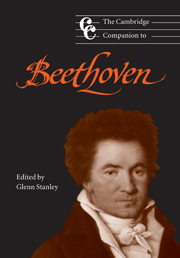Book contents
- Frontmatter
- Part I A professional portrait
- Part II Style and structure
- Part III Genres
- Part IV Reception
- 14 “With a Beethoven-like sublimity”: Beethoven in the works of other composers
- 15 Beethoven's music in performance: historical perspectives
- 16 The four ages of Beethoven: critical reception and the canonic composer
- 17 Beethoven at large: reception in literature, the arts, philosophy, and politics
- Notes
- Selected further reading
- General index
- Index of Beethoven’s compositions and sketches
- Plate section
16 - The four ages of Beethoven: critical reception and the canonic composer
from Part IV - Reception
Published online by Cambridge University Press: 28 September 2011
- Frontmatter
- Part I A professional portrait
- Part II Style and structure
- Part III Genres
- Part IV Reception
- 14 “With a Beethoven-like sublimity”: Beethoven in the works of other composers
- 15 Beethoven's music in performance: historical perspectives
- 16 The four ages of Beethoven: critical reception and the canonic composer
- 17 Beethoven at large: reception in literature, the arts, philosophy, and politics
- Notes
- Selected further reading
- General index
- Index of Beethoven’s compositions and sketches
- Plate section
Summary
Of the reception of Beethoven's music these last two hundred years, one thing is clear: there has been little trace of the tidal cycles of popular and critical approbation suffered by almost every other important composer. More specifically, no significant ebb tide has yet been charted in the reception of his music. Or it may be that his fortunes are subject to a tide table of an exceedingly grander temporal scale: perhaps Beethoven will go out of fashion for the next two hundred years, only to return with force in some unthinkable new world. And yet, his image – however abiding – has not simply stood in place over the last two centuries, like some historically inert monolith. One may mark discernible stations in the critical reception of his life and music, points in the historical flow that seem to gather into a larger narrative.
I would like to construct four such stations, each anchored to a symbolic milestone in the history of Beethoven reception: 1827, death of Beethoven and birth of the artist as Romantic revolutionary and hero; 1870, centenary of Beethoven's birth and symbolic rebirth of the composer as a spiritual and political Redeemer; 1927, centenary of the composer's death and symbolic death of the figure of the Romantic artist in favor of that of the law-giver and natural force; and 1970, bicentennial of the composer's birth and symbolic birth of the culturally constructed hero. Beyond tracing the vibrant afterlife Beethoven has enjoyed in mainstream Western musical thought, the resulting trajectory illuminates a perhaps typical process of canon formation, whereby a canonic subject is gradually transformed into a canonic object.
- Type
- Chapter
- Information
- The Cambridge Companion to Beethoven , pp. 272 - 291Publisher: Cambridge University PressPrint publication year: 2000
- 4
- Cited by

